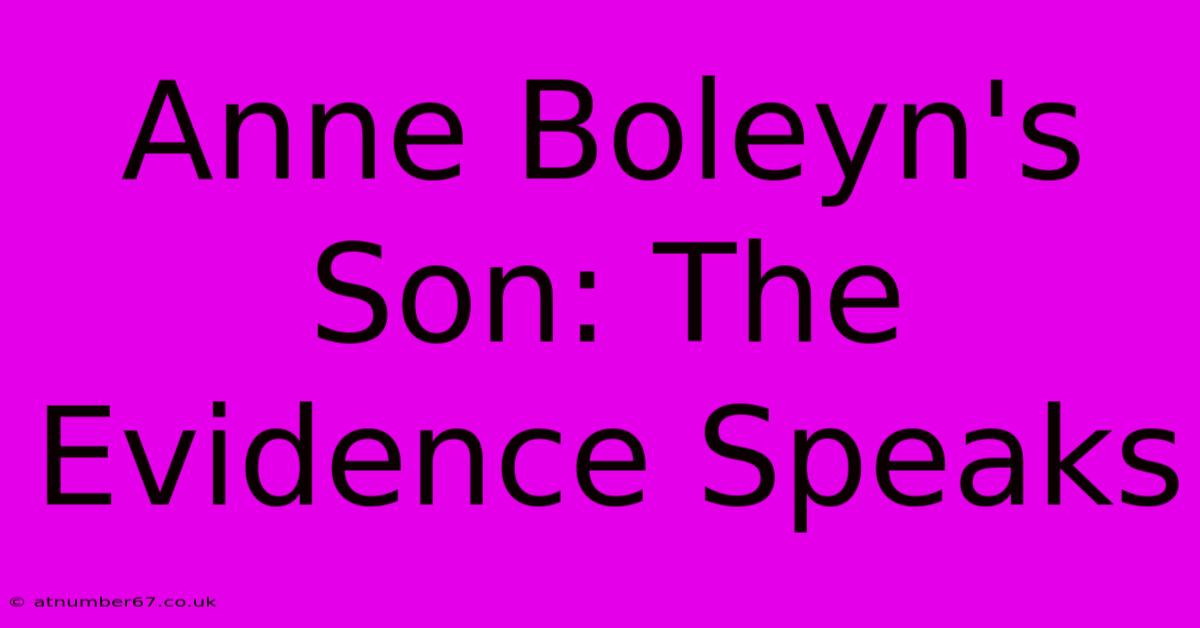Anne Boleyn's Son: The Evidence Speaks

Table of Contents
Anne Boleyn's Son: The Evidence Speaks
The question of whether Anne Boleyn bore Henry VIII a son lingers as one of history's most enduring mysteries. While officially, the only surviving child of their marriage was Queen Elizabeth I, whispers and theories about a son persist. This article delves into the evidence – or lack thereof – surrounding the possibility of Anne Boleyn having a son, exploring the historical records and analyzing their reliability.
The Official Narrative: Elizabeth I and the Absence of a Son
The accepted historical narrative firmly establishes Queen Elizabeth I as the sole surviving child of Henry VIII and Anne Boleyn. Contemporary accounts, royal records, and official portraits consistently depict Elizabeth as the only offspring of this union. No credible contemporary source mentions a son. This lack of documented evidence forms the bedrock of the conventional understanding.
Examining Primary Sources: The Silence is Telling
Historians rely heavily on primary sources – documents and records created at the time of the events – to reconstruct the past. The absence of any mention of a son in the extensive surviving correspondence, court records, and chronicles of the Tudor period is striking. Considering the intense scrutiny surrounding Anne Boleyn and the high stakes involved in royal succession, the omission of a son is a significant point. If a son existed, his birth and survival would have been momentous news, almost impossible to suppress completely.
The Rumors and Speculation: Where the Theories Begin
Despite the overwhelming absence of evidence from primary sources, persistent rumors and speculation surrounding a potential son persist. These theories often hinge on interpretations of ambiguous passages, circumstantial evidence, and a desire to fill gaps in the historical record.
Interpreting Ambiguity: The Challenges of Historical Analysis
It's crucial to approach historical analysis with a critical eye. Many "clues" used to support the theory of a son are based on potentially misinterpretations or lack of context. For example, vague references to children or family members in surviving letters may be misconstrued or refer to other individuals entirely. Ambiguity doesn't automatically equate to evidence of a hidden son.
The Power of Narrative: Why the Legend Persists
The enduring appeal of the "lost son" theory likely stems from several factors. It adds intrigue to a historically significant period, allows for imaginative speculation, and fits into the wider narrative of Anne Boleyn’s tragic downfall. This narrative potential, however, shouldn't be mistaken for factual evidence. The legend's longevity is not a validation of its truth.
Conclusion: A Lack of Evidence Reigns Supreme
The evidence strongly suggests that Anne Boleyn did not have a son. The overwhelming silence of contemporary sources, the official record favoring only Queen Elizabeth I, and the lack of corroborating evidence outweigh any speculation based on ambiguous passages or wishful thinking. While the romantic notion of a hidden heir adds to the fascination surrounding Anne Boleyn, a responsible assessment of the available historical data points firmly against the existence of a son. The focus should remain on the rich and complex history of Elizabeth I, the only documented child of Anne Boleyn and Henry VIII.
Keywords: Anne Boleyn, Henry VIII, Elizabeth I, Tudor dynasty, Royal children, lost son, historical mystery, primary sources, historical evidence, Tudor history, royal succession.

Thank you for visiting our website wich cover about Anne Boleyn's Son: The Evidence Speaks. We hope the information provided has been useful to you. Feel free to contact us if you have any questions or need further assistance. See you next time and dont miss to bookmark.
Featured Posts
-
The New Age Of My Country Innovation And Growth
Apr 04, 2025
-
Sung Jin Woo Son A Testament To Courage
Apr 04, 2025
-
Secrets And Lies A Familys Dark Past
Apr 04, 2025
-
Will Halle Bailey Become A Billionaire
Apr 04, 2025
-
Daughters 1st Birthday The Best Year Yet
Apr 04, 2025
